
Sweating Treatment Page Menu: 1 2 3 4 5 Next>>
Sweating Humoral Treatment in the Golden Age of Piracy, Page 3
Healing By Natural Sweat
"I think he is therefore very rash that goes about to force the Disease by Provoking Sweat, and to cure the Patient by that Method alone; whereas the divine old Man says, That 'tis vain to do any thing contrary to Nature's Inclination." (Thomas Sydenham, The Whole Works of Dr. Thomas Sydenham, 3rd ed, 1701, p. 159)
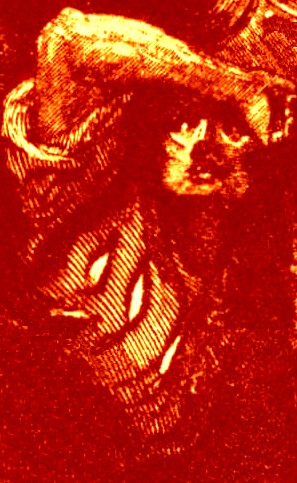
Artist: Gustave Doré
From the Rime of the Ancient Mariner (1866)
Natural sweating was believed by some physicians to be superior to the various forms of artificially generated sweat. Thomas Sydenham repeats this idea several times, citing Hippocrates' work by way of proof.
Sydenham discusses his theory about the way natural sweating works while talking about fevers. He explains that sweating "is Natures own method by which she casts out the Febrile [fever-causing] Matter, and is more Genuine and Commodious than the rest, when Nature is left to it self, it first digests the aforesaid Matter, and then when it is well Concocted, gently expels it through the habit of the Body; which happy event of Nature, of curing Fevers by Sweating"1.
Illnesses were believed to be caused by unwanted elements that lay buried in the humors. This required processing or refining by the body (and nature) to make it possible for them to be ejected. When discussing intermittent fevers (recurring fevers that came with malaria and other tropical illnesses), Sydenham explains that nature will "evacuate the Morbifick [disease-causing] Matter, now prepared at an appointed time."2 For continual fevers (long-lasting fevers seen in pneumonias and influenzas), he identifies the culprit as a "Humour as is ripened by Digestion [breaking down]" which nature will then sweat out.3
You may have noticed that Sydenham refers to the body as both concocting unwanted elements (which suggests they were combined with something to be removed) and digesting them (which suggests they are broken down). Although these appear to be opposite operations, Sydenham does say when discussing Venice-Treacle (a sudorific) that it is a 'great' remedy for diseases which "proceed from want of Heat and Concoction, or Digestion"1. This could be read as suggesting that these two processes were similar or even the same, although without further explanation this is not entirely clear.
Sydenham points out that unprocessed humors are the reason that medically induced sweating is useless in most fevers. "For ...Art [referring to the work done by medical practitioners to procure sweat unnaturally] know[s] not by what means the peccant [disease-causing] Matter should be fitly prepared to undergo Expulsion, and if it should know this, yet it has no certain Signs by which it may be admonished [urged] of the due Preparation of it: So that also it is unavoidably ignorant of the fit time of provoking Sweat."5
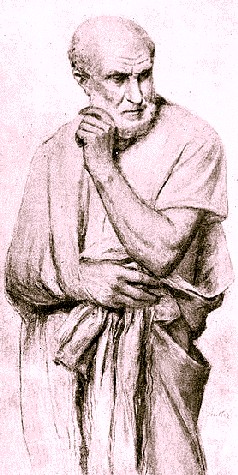
Artist: Albert Anker
Hippocrates, A Composite Sketch from Study of
Ancient Coins and Medals
Sydenham goes on to warn "it is very dangerous to provoke Sweat rashly [using artificial methods], before a due Concoction" because it results in the disease-causing elements being "more heightened, and becomes a confirmed and radicated [deeply-rooted] Disease."6 He explains "that while we diligently provoke Sweat [by artificial means] to lessen the Fever [in small pox], at the same time we force out a crude and indigested Humour, like over-early Fruit: And by these very Sweats, we afterwards occasion a violent Fever; for by this means the Serum of the Blood ...is driven out, and in the mean while, these Particles wax violent, because they are now freed from the Serum, which was exhausted by Sweat."7 By way of authority, he twice cites Hippocrates axiom 'Things concocted, not crude, are to be medicated'8.
Sydenham also advises that not all natural sweats accompanying a fever have healing capability. He explains that "those Sweats that come at the beginning of the Fever are altogether Symptomatical, not critical" and that their role in curing the fever is "most commonly not at all"9.
Although he is the most vociferous, Sydenham is not the only author to promote the value of natural sweating in cures. Ambroise Paré explains that skin infections are "terminated either by insensible transpiration [unforced sweat], or by the moisture of the skin, or by a sweat naturall, gentle, and not ill smelling"10. In treating erysipelas [St. Anthony's Fire - an acute inflammation of the skin], physician Robert James tells his readers they must "preserve a free Respiration of the Parts affected, which can never be obtain'd under a cold State of Air, an intense heat, or a great Load of Cloaths [all artificial methods for causing a patient to sweat], but under a moderate Heat which excellently encourages Perspiration."11 Naval physician William Cockburn says, "In the Cure of Fevers we see, that those people, that are left to themselves, and take no Medicins, shake off their Fever by Sweating, Looseness, a Hemorrhagy, Diabetes [referring here to urination, a symptom of untreated diabetes], &c."12
1 Thomas Sydenham, The Whole Works of Dr. Thomas Sydenham, 3rd ed, 1701, p. 433; 2 Sydenham, p. 159; 3 Sydenham, p. 108; 4 Sydenham, p. 324; 5 Sydenham, p. 433; 6 Sydenham, p. 434; 7 Sydenham, p. 278; 8 See Sydenham, p. 108 & 434; 9 Sydenham, p. 434; 10 Ambroise Paré, The Workes of that Famous Chirurgion Ambrose Parey, 1649, p. 204; 11 Robert James, Pharmacopœia universalis, 1747, p. 196 (the second page 196 due to irregular pagination); 12 William Cockburn, An Account of The Nature, Causes, Symptoms and Cure of the Distempers That are incident to Seafaring People, 1696, p. 90
Healing By Artificial Sweat
"For Nature is to be assisted in the way she endeavours to discharge her self of the morbific Matter: Observing this Rule, you cannot well fail of Success in your undertakings." (Thomas Aubrey The Sea-Surgeon or the Guinea Man’s Vadé Mecum., p. 27)
Despite the recommendation for natural sweating as being preferred in illnesses, many authors preferred to use artificial means to procure sweat in cases where it was required. A variety of different methods were employed by physicians and surgeons to raise a sweat including simple heating elements, hot-houses built to cause sweating and sweat-inducing diaphoretic and sudorific medicines. Coupled with these artificial methods was an element of danger in raising an inappropriate sweat according to some period physicians. Let's look at these facets of healing by artificial sweat.
Healing By Artificial Sweat - Simple External Heating
Several simple heating elements could be used to force a patient to sweat. Among the most prevalent were fires, blankets and hot items applied externally to the body.
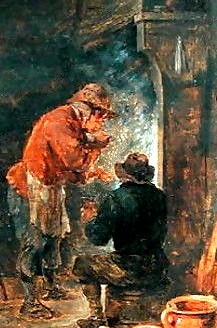
Artist: David Teniers the Younger
Gathered Around the Fire (1645)
The most straightforward way of increasing the heat when the doctor wanted to cause someone to sweat was to put them in a room with a lighted fire. Richard Wiseman recommended placing a patient in a room by "a Stove, if it may be had, and the Patient can bear it; if he be weak his Bed must be used, otherwise for want of a Stove he must sit incompassed with a screen ...by the fire side but not too near it."1 He gives greater detail about the use of a stove. "The Stove is the most easie in regard they [the patients] may sit, stand or walk up and down... [When the patient is to be sweated in bed,] Stoves that are near to a good bed are best; the other which you must go up or down stairs to, are not allowable."2
In his book on treating the pox Physician Joannes Sintelaer likewise advises that the patient "be oblig’d to keep constantly (during the Cure) in his Chamber, which must be kept close and warm, by keeping a constant Fire there less or more, according to the Difference of the Season, and the Condition of your Patient"3.
As part of a method for turning a ship's cabin into a sweating room (the details of which are explained in the next section), sea surgeon John Moyle advises that "if there were a small pot or pan of Fire in the Cabbin, it were so much the better."4 One limitation of fires on a ship was that they could only be used when the ship was at anchor; fires were not lit when the ship was in motion or in battle for fear that they might be upset and set fire to the wooden vessel.
Another method for encouraging sweat was to cover the patient in warm fabrics. Many practitioners suggest using 'bed clothes' (blankets, sheets and other bed coverings) for this purpose. French surgeon Ambroise Paré recommends that 'to provoke sweat' a patient "must bee put Warm to bed, and covered with manie cloaths"5. After giving sweating medicines for the pox, Joannes Sintelaer orders "you must cover him very well with Blankets, or other Bed-cloaths, to make him Sweat soundly"6. Thomas Sydenham
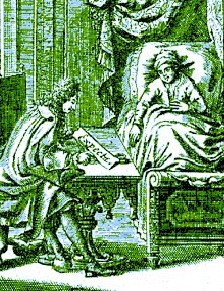
Artist: Goerg Ernst Sthal
From Ars Sanandi, Frontispiece,
(1730)
orders pox patients "to be cover’d quite over whith Clothes, and that a piece of Flannel be bound to the fore-part of his Head; and indeed this covering of the Head conduces more to the procuring sweat than any one would easily imagine."7
Regular clothing was also used to warm patients and help force a fever. Richard Wiseman says a patient should be put in warm clothing such "as the Legs with stockings, Thighs with trouzers, &c. till at last his neck be well wrapped with a napkin tacked up to his Cap round about to his ears, and fastned before to keep his chaps warm. After this a warm Bed will be convenient"8. Thomas Sydenham advises that when treating intromittent (malarial and tropical) fevers patients should be given sweat-inducing medicine followed by "the Patient being well cover'd with Clothes, which must be continued as long as he can bear it"9.
Sea surgeon John Moyle orders patients to "have a warm Shift put on, and another warm Cap on his Head" when sweating in tropical fevers or calentures.10 When treating the pox, Moyle tells the surgeon "you must have ready Flannel Stockins, Drawers, Shirt and Wastcoat, as likewise Flannel Muffler and Cap, for the Body must be kept exceeding warm"11. (Note that Moyle was using salivation medicines in this example, which also caused sweating.)
In his recollections, Silas Told describes a treatment of rheumatism which he used in 1734. To remove the 'violent cold' that he felt created the problem, he drank a bunch of water, and laid in bed after covered up "very warm." This did not produce a sweat, so he decided to be more vigorous in his methods.
I put my head under the cloaths [sheets and covers of the bed], and breathed hard on the pit of my stomach; this produced a perspiration, and that in a profuse measure. I then desired my attendant to bring me half a dozen well-dried and warm flannels, in order to rub me from head to foot: He did this likewise, and continued his rubbing till I had made five shirts in a condition equal to the dipping of them in water.12
As a result of this self-prescribed treatment, Told said he became "totally exempt from every the least symptom of the rheumatism and pain"13.
A third simple external method for procuring sweat was to place warm items next to the patient. Ambroise Paré suggests
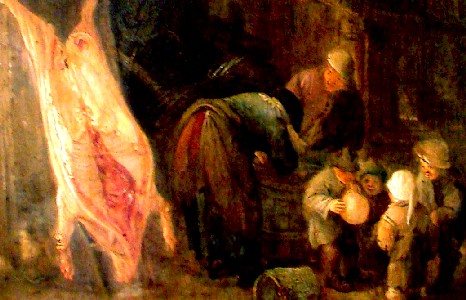
Artist: Isaac van Ostade -
Children with Swine's Bladder, The Dismemberment of the Pig (1645)
treating the gout in this way: "Take a great ridg-tile thick and strong, and heat it red hot in the fire, then put it onto such another tile of the same bigness, but cold; least it should burn the bed-clothes... Then let the patient endure the heat that com’s therefrom, and by sweat receiv the fruit thereof, for the space of an hour"14.
For treating a body part afflicted with palsy [paralyses, sometimes with tremors] he says that "when sweat doth not flow it shall not be unprofitable to put about the resolved members, bricks heated red hot in the fire and quenched to a decoction of Wine, Vinegar, and resolving herbs, or also stone bottles, or Ox and Swine bladders, half filled with the same decoction; for such heat which is actually resuscitateth and strengthens the heat of the part"15.
He also ordered that a patient with the bubonic plague was to be covered up in bed with "warm brick-bats or tiles applied to the soles of his feet; or in stead thereof you may use swine bladders filled with hot water, and applie them to the groins and arm-holes [armpits], to provoke sweat"16.
1 Richard Wiseman, Eight Chirurgicall Treatises, 3rd Edition, p. 495; 2 Wiseman, p. 497; 3 Joannes Sintelaer, The Scourge of Venus and Mercury, 2nd ed,, 1709, p. 248; 4 John Moyle, The Sea Chirurgeon, 1693, p. 148; 5 Ambroise Paré, The Workes of that Famous Chirurgion Ambrose Parey, 1649, p. 555; 6 Sintelaer, p. 242; 7 Sydenham, p. 73; 8 Wiseman, p. 495; 9 Thomas Sydenham, The Whole Works of Dr. Thomas Sydenham, 3rd ed, 1701, p. 41; 10 Moyle, p. 159; 11 Moyle, p. 148; 12,13 Silas Told, An Account of the Life and Dealings of God with Silas Told,, 1805, p. 54-5; 14 Paré, p. 459; 15 Paré, p. 260; 16 Paré, p. 555
Healing By Artificial Sweat - Hot Houses
Hot houses were similar to what we think of today as saunas - rooms specifically designed to create a moist, hot atmosphere which causes patients to sweat. This may seem like something beyond the reach of most surgeons at sea, but the popularity of hot house treatments in fevers and the pox led to a variety of clever methods being devised to replicate, if not actually create, hot house-like atmospheres in small spaces such as those found on ships. Let's begin with actual hot houses and their relationship to the navy.
The Ely House was used as an 'as needed' hospital by the English army and navy during the three Anglo-Dutch Wars of the 17th century (1652-4, 1665-7 and 1672-4).

Artist: William Henry Prior
Ely House and St. Ethedredas Cathedral As They Were in 1772 (1828)
It contained a hot house which is described in some detail by Eric Gruber von Arni:
At Ely House, two male nurses supervised the soldiers who sat or reclined in cubicles while smoking from issued clay pipes, and wearing special caps and heavy baize coats in the atmosphere of a Turkish bath created by a copper bath stove from which heat was channeled to each cubicle. No expense was spared in running this faculty – in one week alone one hundred and ten sheets and many towels were sent for launding... Other regular provisions for the hot-house included the liberal supply of claret wine and sugar.1
The Ely House was run by physicians (as opposed to the more work-a-day surgeons) who were likely to prescribe sweating and similar humor-based treatments. During the Anglo-Dutch wars, it was largely reserved for treating officers. (This may explain the claret wine.) Gruber von Arni suggests that the hot house was used primarily to treat venereal cases2, although we have seen that sweating was popularly used for many other health problems.
Sweating became a popular treatment for fevers during the early part of the 17th century3, resulting in sweating cabins being built in some navy

Artist: Peter Monomy
First Rate Ship HMS Royal Sovereign (early 18th century)
ships. Naval physician William Cockburn described the use of these ship-based hot houses in 1736:
Howsoever, this Success [of sweating in fevers] was so conspicuous, that most of the Ships in the Fleet had sweating Cabins built them. A number of Men was sweated in those Cabins every day, and turned out to their Births in the Evening, after the Sweating was over That Evening the Cabin was washed and aired, and they that were to sweat next day, had their Hammocks hung by the Cabin-door, the preceding Night.5
Although that statement indicates that 'most' of the ships in the navy had such cabins, it seems more likely that such an extravagance would more likely have been found on Ships of the Line than the smaller vessels. (Without corroborating evidence, this is impossible to verify.) However prevalent they were, they would almost certainly not be found on many merchant or pirate ships. This is where the creative small-space hot house-like devices may have been employed.
The simplest form of hot house is one devised primarily by nature. Joannes Sintelaer explains that "the Indians... by means of the young Sprouts or Twigs of this Tree [guaiacum - a sudorific] which they boil in Water, and drink very plentifully of they often Cure them selves of the Venereal Disease, without any other Help, than by burying themselves in the hot burning Sand near the Sea Side, up to the Neck, where they Sweat most vehemently, as long, as they are able to endure it"6.
Privateer William Dampier, ever ready to try local practises, utilized this method while on Prince George Island on the west coast of North America where he was sweated to treat his 'Dropsie' (Edema). He explains that he was "covered all but my head in the hot Sand: I indured it near half an hour, and then was taken out and laid to sweat in a Tent."7

Sweating Frame, Armamentarum Chirurgiae Appendix, Johannes Scultetus (1671)
The English had recourse to more sophisticated methods as well. Military surgeon Richard Wiseman recommends turning a room into a 'close warm Chamber' where "the windows must be covered with blankets, and the bed near the fire, and incompassed with a Screen if the Chamber be large."8 Wiseman elsewhere describes the the screen (which he also refers to as a frame) in some detail:
You are to fold a well aired Sheet four double and lay it under the Patient, then his Shirt being stript off, the Frame must be placed over him, and a sheet over that Frame, and as many Blankets over that Sheet, and both Sheet and Blankets must be brought over the end of the Frame; and be tucked down close to the neck; then a pan of well burnt Charcoal or Spirit of Wine [brandy] must be put into the lower end of the Frame: this done shut the door and take care that the heat be kept in, especially about the Patients neck lest it stifle him.9
Wiseman further explains that 'a couple of Servants' must attend a patient lying in a screen by wiping sweat off his face, feeding him cloths to wipe the sweat from his body and tending to the fire. Wiseman notes that such patients "commonly sweat 3 quarters of an hour in the Frame, and an hour in bed after the Frame is pulled away"10.
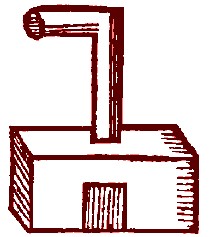
Sintelaer's 'Tin Box Oven, From The
Scourge of Venus and Mercury, p. 231 (1709)
Although Wiseman doesn't provide a lot of detail on the design of the screen/frame, it is most likely similar to a method recommended by physician Joannes Sintelaer. To create his miniature hot house, Sintelaer puts a naked patient in bed "and over his Body are extended three or four half Hoops, in order to keep the Bed cloaths from touching his naked Body"11. Brandy is put into a 'Tin Box' (seen at right) with a door in the side and set on fire. He explains that "the Vapour thereof will ascend thro' the Pipe (one End of which is put under the Bed-cloaths thus) to the Body of the Patient and make it sweat most plentifully in a little time, which you may continue as long as you see it convenient"12.
Sintelaer also explains how the same procedure can be used with a chair. This is done by covering the patient "all round very close up to the Chin, and the Chair - also behind with warm Blankets. This done set a small Quantity of Spirit of Wine a Fire in a little Vessel, and put it under the Chair"13. He also notes that "ordinary Wood-fire Coals well burnt thro’ [can be used], instead of the Spirit of Wine, or else of Boiling hot Water, with such Herbs as are adapted to the Constitution of your Patient". However, he says brandy (spirit of wine) is best "because this Spirit by its oleagenous [oily] and most volatile Particles not only most powerfully penetrates thro’ the Pores, but also volatilizes [evaporates] the viscid slimy Part of the Venereal Poison, and expels it along with the Sweat out of the Body"14.
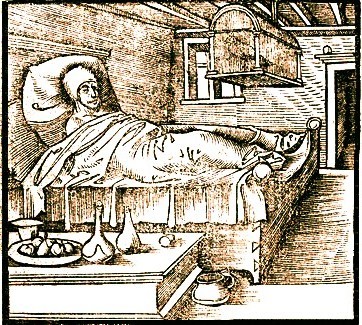
A Makeshift Sweating Room - Note the Lit Pot, Bottom Center (16th c.)
If there is any doubt that a hot house could (and was) set up at sea for sweating a patient on a ship during the golden age of piracy, sea surgeon John Moyle lays that doubt to rest. When treating rheumatism, Moyle advises his reader that, if possible, "make way with your Patient to the Hot-house, and there let him be Sweat and rub'd to purpose"15. However, this wasn't possible when the ship was at sea. "Therefore my Advice is, If you are not in place where a Hot-House is, that you imitate it, and make·something like it, to do your Cure in."16
Moyle explains his method for creating a hot house on a ship in his cure for the pox. The patient is first to be dressed in warm clothing. "Then the Patient must be laid in Flannel Sheets, and covered well, the Room or Cabbin must be hung about with warm hangings [probably referring to heavy cloth], that no cold come in; and if there were a small pot or pan of Fire in the Cabbin, it were so much the better."17 You will immediately see the similarities between Moyle's construct and the makeshift hot houses discussed previously by Sintelaer and Wiseman.
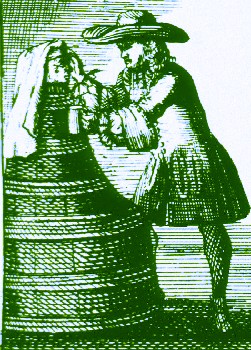
Sweating in a 'Bath', David Abercromby (1691)
Similar to hot houses was sweating using a 'bath.' When discussing the cure of scurvy, sea surgeon John Woodall advised that "sweating in moist baths I confesse to be good medicines in this case, though not well to bee performed at Sea for the ordinary men."18
For palsies, French surgeon Ambroise Paré explained how a 'bath' worked when sweating men. They were to be put "into a bathing-tub, which is veiled or covered over"19. A mixture of herbs were put in with him so he could breathe in their vapor. He was to "keep himself in that Bathing-tub, as long as his strength will give him leave, then let him be put into his bed well covered, where he shall sweat again, be dried and rest."20
Sintelaer also mentions the use of a wooden tub for sweating. He explains that the tub must have a door in the side "thro' which you may put a Pan with burning Wood-coals, the Patient, being plac'd upon a Bench within the Tub, and his Feet resting upon something at some Distance from the Bottom, and all the upper Part of his Body being cover’d very close with Blankets up to the Chin; by this Means you may promote the Sweat"21. He also says that boiling water with herbs can be used (similar to Paré) or even water thrown on heated stones "by which means the Vapour of the Decoction will ascend and surround the Body and raise a very easie and agreeable Sweat."22 However, as Woodall says, such a method would not be quite as practical on a ship as Moyle's hot house.
1 Eric Gruber von Arni, “Who Cared? Military Nursing during the English Civil Wars and Interregnum, 1642-60”, British Military and Naval Medicine, 2007, p. 133 2 Gruber von Arni, p. 132; 3 John J. Keevil, Medicine and the Navy 1200-1900: Volume II – 1640-1714, p. 292; 4 William Cockburn, Sea Diseases, Or, A Treatise Of Their Nature, Causes, Symptoms and Cure, 1736, p. 144-5; 5 Cockburn, p. 152; 6 Joannes Sintelaer, The Scourge of Venus and Mercury, 2nd ed,, 1709, p. 234; 7 William Dampier, A New Voyage Round the World, 1699, p. 276; 8 Richard Wiseman, Eight Chirurgicall Treatises, 3rd Edition, p. 495; 9,10 Wiseman, p. 497; 11 Sintelaer, p. 230; 12 Sintelaer, p. 230-1; 13 Sintelaer, p. 231; 14 Sintelaer, p. 232; 15,16 John Moyle, The Sea Chirurgeon, 1693, p. 221; 17 Moyle, p. 148; 18 John Woodall, the surgions mate, 1617, p. 187; 19,20 Ambroise Paré, The Workes of that Famous Chirurgion Ambrose Parey, 1649, p. 260; 21 Sintelaer, p. 232; 22 Sintelaer, p. 233

